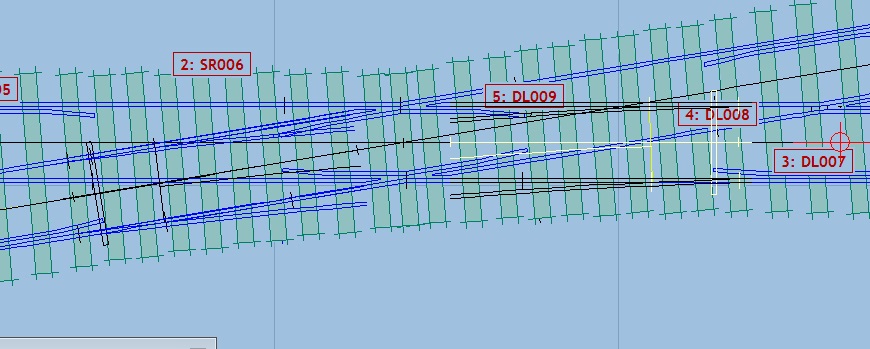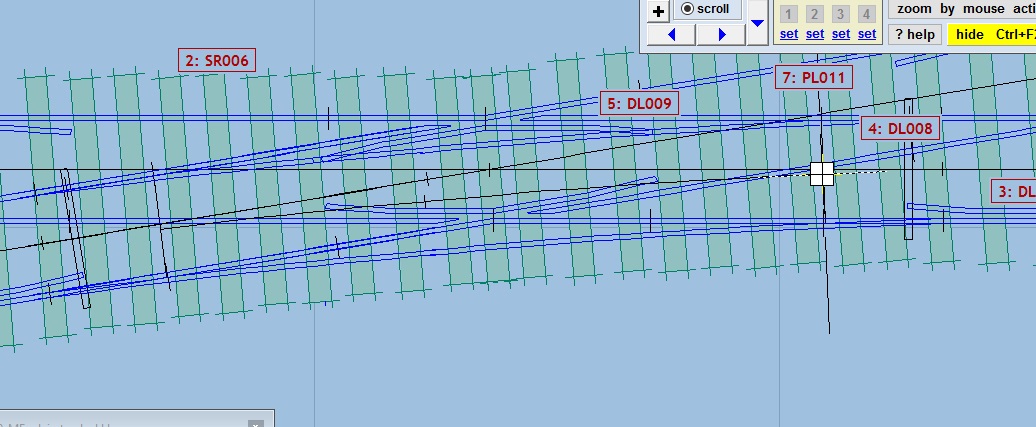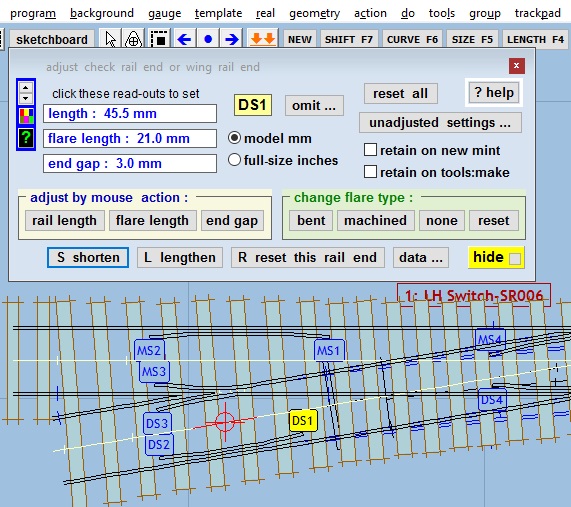Single Slip - Templot and Building
This was written in the forum by Steve Bannister
A few weeks before the old Forum closed a member was seeking help with drawing and building a single slip. I was part way through this process myself so I thought it might be helpful if I posted here how I have been getting on and how I have made progress so far.
I have enjoyed and learned a lot from the Forum so maybe I can share something which others will find interesting and maybe helpful, and I may pick up some tips along the way too.
For the uninitiated, Templot is a free track and layout planning tool created by Martin Wynne quite a few years back now, but which now has a remarkable number of features backed up by an impressive amount of support from Martin himself through the Template Forum on RMWeb.
I must admit I found it quite hard going getting up the learning curve, even though I have a fairly good computer background, but if you persevere it starts to make sense and there are many “experts” who are more than willing to help.
As an introduction I drew and built a simple turnout first as this was the first piece of track I'd built since EM days donkey's years ago.
So to the Single Slip…….
First thing is to Download Templot and to follow the introductory tutorials and practice a bit
You can get all you need here: http://www.templot.com/
First step: Get a picture in your head about what you need to create…..For a single slip this is
A Diamond crossing with the required V crossing angle. The Switch part of a Turnout on each side of the Diamond Centre, opposite hands on the two tracks to be linked. A Slip Road- rails to link the two Switches
So First I'll make a Diamond Crossing, so
Go to the Templot Opening Page you'll see a pre-prepared extended Turnout
 Select the turnout and delete
Select the turnout and delete
Change Gauge to the required one, I used O MF by Gauge> 31.5 OMF; you choose the one you are working to.
SRSteve - Feb 24, 2017 at 7:02 PM
Now start with a turnout matching your desired slip V crossing angle
Template>Quick Set> I chose REA A6, Straight, LH, click OK and your turnout appears on the trackpad as the control template


First thing to do is to convert the turnout to a diamond crossing by Template> Convert to half diamond, once done you should now have this..
 More soon !
More soon !
SRSteve - Feb 24, 2017 at 11:07 PM
SRSteve - Feb 24, 2017 at 11:17 PM
Now you need to extend the sleepers on the side you want the slip to be, if doing a double slip this will be both sides, you should notice the sleepers getting longer on the side(s) you selected. If you do anything wrong at any stage you can undo the previous step(s) by Do> Undo Changes to Control Template
 Then I am ready to make the full diamond crossing
Then I am ready to make the full diamond crossing
 Then you should have this
Then you should have this

Notice that the sleepers at the bottom are extended ; the original half diamond has been saved automatically to the back ground and the mirror image one added to make the full diamond is now the Control
SRSteve - Feb 24, 2017 at 11:18 PM
Before I go any further it is important to understand how Templot works. Your trackplan is made up of a series of templates stored in the Background and you delete the template you want to work on to the “Control”. Once complete you save it back to the background. If modifying a template it’s better to delete it to the control or you may end up with several near identical templates on top of each other in the Background without realising it. Do remember to save your work though!!!
The Peg (indicated by the red circle and X Hairs) can be positioned in a number of places on the Control template and is used for connecting and aligning other components or Templates. The Notch allows you to put a marker (usually on a Peg) on a Template in the background so you can align the Control template to it
More to follow tomorrow
SRSteve - Feb 25, 2017 at 12:12 PM
Up to now, we have one half diamond in the Control, and one in the Background ( Template did this automatically when I created the full diamond). In my version the background is blue and the Control white.
Now I need to create the switches for the slip; I am making a single slip with the slip road at the bottom of the picture.
Zoom out to make a bit of space, then repeat the first step to make another turnout
I always forget to save the second half diamond, so Program> Store and Background, If you forget you can always go to Do> Undo Changes to Control Template
 Template>Quick Set> I chose REA A6, Straight, LH again, click OK and your turnout appears on the trackpad as the control template as before
Template>Quick Set> I chose REA A6, Straight, LH again, click OK and your turnout appears on the trackpad as the control template as before
Now all we want from this turnout is the switch, we do not need the timbers as they are already in place on the half diamond.
So first remove the timbers Real> Timbering > No Timbering

SRSteve - Feb 25, 2017 at 12:16 PM
For my slip I need a switch from the lower left diagonal line curving right, I am going to do this first, and one from the right hand straight (main) line curving left.
So I swapped my turnout round by Template> Mirror Left/ Right and it should look something like this…….
 If I now Do> Snap to Switch Heel all the turnout beyond the heel is removed. Magic !! It looks like this now….
If I now Do> Snap to Switch Heel all the turnout beyond the heel is removed. Magic !! It looks like this now….

SRSteve - Feb 25, 2017 at 12:22 PM
 Put a copy of the switch into the Parking Bay as I will need another one for the other end, if you want you can redo it from the start for practice ! So Do> Parking Bay> Bay1 Park Template
Put a copy of the switch into the Parking Bay as I will need another one for the other end, if you want you can redo it from the start for practice ! So Do> Parking Bay> Bay1 Park Template
 Now Delete the Left Half Diamond to the Control….by left clicking anywhere on the Left Diamond and selecting “Delete to Control”
Now Delete the Left Half Diamond to the Control….by left clicking anywhere on the Left Diamond and selecting “Delete to Control”
Check the peg is on TCP Geometry> Peg Positions > Peg on TCP ( when I do the other end I’ll need it on the MCP, i.e the Main ( as opposed to the Diagonal) line), this is needed to get the Switch in the right place

SRSteve - Feb 25, 2017 at 12:25 PM
Save to Background by Program> Store & Background
Now get the Switch back from the Parking Bay: Do> Parking Bay > Retrieve Parked Template
Check the peg is on the switch Datum (Position 0), it should be

SRSteve - Feb 25, 2017 at 12:31 PM
Now the tricky bit !!!!!
We want to align the switch so its red peg sits on the crossing yellow peg !
So, Left Click anywhere on the crossing then Peg/Align Tools > align the control template over and snake onto peg> Facing Trailing/ Facing ……….don’t worry too much about this last setting as you can change when you see it on the Trackpad; Don't panic if the Switch appears wrong handed or back to front; if it appears on the wrong road, you have probably got the peg on MCP when it should be TCP or vice versa. If the latter has happened simply undo what you have done (Do> Undo Changes to Control Template) , Change the peg setting on the crossing (you'll need to make sure it is the control to do this, see above) and repeat and it should be in the right place
 This is what I got……
This is what I got……

SRSteve - Feb 25, 2017 at 12:35 PM
As you can see the Switch is going the wrong way ! No trouble : Template> Switch Hand puts it right; If the Switch is the wrong way round use Template> Swap End for End
 Now get rid of unwanted switch entry rails by Do> Blank up to Switch Toe
Now get rid of unwanted switch entry rails by Do> Blank up to Switch Toe

SRSteve - Feb 25, 2017 at 12:48 PM
I forgot to take a screen shot of the Slip with just the Left end switch in place, but if you look at the picture which follows below, it should be clear, as it should look like the one with both without both
Now Repeat the process for the switch on the Right hand end. Start by Deleting the RH Half Diamond to the Control, checking/ setting the Peg to MCP, then Store & Background.
Get another Switch back from the Parking Bay and Snake onto Peg etc and you should get to this. If the Switch is the wrong way round or turning the wrong way, use Template> Swap Facing/ Trailing/ Swap Handing to correct it. By now you should be feeling pleased with your achievement and a degree of relief; that's how I felt anyway !
SRSteve - Feb 25, 2017 at 12:53 PM
Now I need to Join the Switches with Switch Roads, originally we would have needed to make a separate piece of plain track, snap it onto one of the switches and adjust the length and curve to fit….but now a tool is included to do this so all we need to do is…….go to Tools> Make Slip Road
You’ll probably find the switch road is too long and not curved correctly but it will be pegged onto one of the switches, I will use the Length F4 and Curve F6 buttons to adjust it to fit, Zoom in to get a good alignment
So you may start with this (Slip Road is in Black)

Nearly there now , just a bit of tidying up to do with Check Rail lengths, making sure the slip components are in the right order in the Storage Box (this ensures the slip, and Switches in particular, print correctly) etc.
SRSteve - Feb 25, 2017 at 3:40 PM
I’ve realised that I have done exactly what I warned about earlier so for the right Diamond, I have got 3 Diamonds exactly matched on top of each other, so I am going to the Storage Box to delete the ones I do not need
Program> Storage Box , Choose show List and it will show all the Templates on the current Trackpad, It Is not so important for a simple plan such as this for a single slip, but for a complete layout plan there will be many templates there, it pays to give each template a name so it’s clear what it is for, much easier than trying to remember which one Turnout 125 is !
Delete the LH Diamond to the Control, then Real> Adjust Check Rails…..you’ll notice all the Check Rail ends on the LH Diamond have been labelled and a pop up window has appeared, Select the Check Rail end adjacent to the lower switch (DS1 on mine). You can change the length by button or by dragging with the mouse ; for our purposes using the “Shorten” button will do the job. Before….

SRSteve - Feb 25, 2017 at 3:47 PM
Now we need to adjust the K crossing Check Rail, MS4, which currently extends right across the slip road, Zoom in to do this. Select the MS4 label and I used the adjust by mouse action to reduce the Check Rail length and Flare Length. It a bit of juggle and judgement to make a rail which will fit and do the job. I also changed the Flare Gap to 2.5mm
Before -

Now Programme> Store and Background then repeat for the RH Half Diamond Check Rails and your Slip will be finished and look like this:

SRSteve - Feb 25, 2017 at 4:03 PM
Very Last thing to do is to arrange the Templates in the Storage Box so the Switches are at the bottom of the List; if you do not do this the Switch Blades will not be shown correctly on the print out. Oh Yes….Save your File !!!
When you want to print your slip to build it, here’s a couple of tips 1. Check the Slip is what you wanted – The first time I did it I was worried that the slip seemed a bit long for an A6 Slip and had glued it down ready to build before I realised that somehow it had got changed to A7.5 2. Calibrate the printer 3. Print a second copy for reference as your build will hide the detail on your main template By the way, for a Double Slip, “All” you need to do is repeat the parts for putting the switches and Slip Road in for the second side of the slip. Here are some useful references for further advice and guidance: [URL]http://templot.com/companion/index.html?add_slip_roads.htm[/URL] [URL]http://www.templot.com/martweb/pug_slips.htm[/URL] So next is to start the build !
Jim Snowdon - Apr 3, 2017 at 12:53 PM
You will find a curved one a bit more of a challenge. The technique is just the same, but the need for accurate control of the gauge and the flangeways though the two obtuse crossings is even greater. Whereas in a straight diamond there is a fair chance that the wheels will end up in the right place by default, the same is not true of a curved diamond as the leading outer wheels of any vehicle are going to be in flange contact with the outer rail of the curve, and ready to escape through the flangeway of the obtuse crossing unless properly checked. Unlike common crossings, where there is a continuous check rail, checking through obtuse crossings depends on the length of the immersed flange (that part of the flange that is below rail level) being long enough to bridge the gap between the check and point rails, ie the intersecting flangeway. I built a double curved diamond for our present club layout -

and found that whilst the rest of the layout is laid to 31.5mm gauge, the centre of the crossing had to be laid to the tight side of 31.25mm so as to get the flangeways down to the minimum practicable with fine standard wheels (ie 30.00mm check gauge, 0.75mm flange thickness). It works really well, but is good at sorting out good wheels from bad when it comes to standards. Not everything Heljan will go through without the wheels being modified, but that is more a reflection of Heljan's lax control over their wheelset dimensions. It terms of its construction, I built the core of the diamond as a single unit, using shallow depth pcb pads under the rails through the crossings and cutting the isolation gaps in the point rails with a saw only after the unit was complete. Leaving that until then makes a considerable difference in keeping all the point rails aligned. Best of luck with the project, Jim











